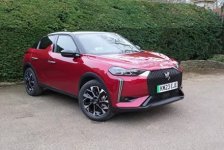DS Automobiles, the premium French brand, offers a diverse lineup catering to various preferences and needs. Here's a comprehensive comparison of the DS 3, DS 4, DS 7, and DS 9 models to help you determine which suits you best.
DS 3
Type: Subcompact SUV
Engine Options:
1.2L PureTech petrol engine
Electric variant (E-TENSE)
Performance:
0-60 mph in approximately 8.9 seconds (PureTech 130)
0-60 mph in approximately 8.7 seconds (E-TENSE)
Electric Range (E-TENSE): Up to 250 miles (WLTP)
Seating Capacity: 5 passengers
Dimensions:
Length: 4,118 mm
Width: 1,791 mm
Height: 1,534 mm
Pros:
Compact size ideal for urban environments
Electric variant with a respectable range
Cons:
Limited rear-seat space
Smaller cargo capacity compared to larger models

DS 4
Type: Compact Hatchback
Engine Options:
1.2L PureTech petrol engine
Plug-in hybrid (E-TENSE 225)
Performance:
0-60 mph in approximately 7.5 seconds (E-TENSE 225)
Electric Range (E-TENSE 225): Up to 38.5 miles (WLTP)
Seating Capacity: 5 passengers
Dimensions:
Length: 4,400 mm
Width: 1,830 mm
Height: 1,470 mm
Pros:
Stylish design with premium interior
Efficient plug-in hybrid option
Cons:
Rear visibility can be limited due to design
Higher trims can be pricey
DS 7
Type: Mid-size SUV
Engine Options:
1.6L PureTech petrol engine
Plug-in hybrid (E-TENSE 225 and E-TENSE 4x4 300)
Performance:
0-60 mph in approximately 7.9 seconds (PureTech 225)
0-60 mph in approximately 5.4 seconds (E-TENSE 4x4 300)
Electric Range (E-TENSE 225): Up to 40 miles (WLTP)
Seating Capacity: 5 passengers
Dimensions:
Length: 4,573 mm
Width: 1,906 mm
Height: 1,625 mm
Pros:
Spacious interior with advanced technology
Strong performance, especially in hybrid variants
Cons:
Larger size may be less maneuverable in tight spaces
Higher fuel consumption in non-hybrid models
DS 9
Type: Executive Sedan
Engine Options:
1.6L PureTech petrol engine
Plug-in hybrid (E-TENSE 225 and E-TENSE 250)
Performance:
0-60 mph in approximately 8.0 seconds (E-TENSE 225)
0-60 mph in approximately 7.8 seconds (E-TENSE 250)
Electric Range (E-TENSE 250): Up to 46 miles (WLTP)
Seating Capacity: 5 passengers
Dimensions:
Length: 4,934 mm
Width: 1,932 mm
Height: 1,460 mm
Pros:
Luxurious interior with ample rear-seat space
Smooth ride quality ideal for long journeys
Cons:
Larger dimensions may be challenging in urban settings
Higher starting price compared to other models
Conclusion
Your choice among the DS models depends on your specific needs:
DS 3: Ideal for urban drivers seeking a compact SUV with an electric option.
DS 4: Suited for those desiring a stylish compact hatchback with hybrid efficiency.
DS 7: Perfect for families needing a spacious SUV with strong performance
Youtube
DS 3
Type: Subcompact SUV
Engine Options:
1.2L PureTech petrol engine
Electric variant (E-TENSE)
Performance:
0-60 mph in approximately 8.9 seconds (PureTech 130)
0-60 mph in approximately 8.7 seconds (E-TENSE)
Electric Range (E-TENSE): Up to 250 miles (WLTP)
Seating Capacity: 5 passengers
Dimensions:
Length: 4,118 mm
Width: 1,791 mm
Height: 1,534 mm
Pros:
Compact size ideal for urban environments
Electric variant with a respectable range
Cons:
Limited rear-seat space
Smaller cargo capacity compared to larger models

DS 4
Type: Compact Hatchback
Engine Options:
1.2L PureTech petrol engine
Plug-in hybrid (E-TENSE 225)
Performance:
0-60 mph in approximately 7.5 seconds (E-TENSE 225)
Electric Range (E-TENSE 225): Up to 38.5 miles (WLTP)
Seating Capacity: 5 passengers
Dimensions:
Length: 4,400 mm
Width: 1,830 mm
Height: 1,470 mm
Pros:
Stylish design with premium interior
Efficient plug-in hybrid option
Cons:
Rear visibility can be limited due to design
Higher trims can be pricey
DS 7
Type: Mid-size SUV
Engine Options:
1.6L PureTech petrol engine
Plug-in hybrid (E-TENSE 225 and E-TENSE 4x4 300)
Performance:
0-60 mph in approximately 7.9 seconds (PureTech 225)
0-60 mph in approximately 5.4 seconds (E-TENSE 4x4 300)
Electric Range (E-TENSE 225): Up to 40 miles (WLTP)
Seating Capacity: 5 passengers
Dimensions:
Length: 4,573 mm
Width: 1,906 mm
Height: 1,625 mm
Pros:
Spacious interior with advanced technology
Strong performance, especially in hybrid variants
Cons:
Larger size may be less maneuverable in tight spaces
Higher fuel consumption in non-hybrid models
DS 9
Type: Executive Sedan
Engine Options:
1.6L PureTech petrol engine
Plug-in hybrid (E-TENSE 225 and E-TENSE 250)
Performance:
0-60 mph in approximately 8.0 seconds (E-TENSE 225)
0-60 mph in approximately 7.8 seconds (E-TENSE 250)
Electric Range (E-TENSE 250): Up to 46 miles (WLTP)
Seating Capacity: 5 passengers
Dimensions:
Length: 4,934 mm
Width: 1,932 mm
Height: 1,460 mm
Pros:
Luxurious interior with ample rear-seat space
Smooth ride quality ideal for long journeys
Cons:
Larger dimensions may be challenging in urban settings
Higher starting price compared to other models
Conclusion
Your choice among the DS models depends on your specific needs:
DS 3: Ideal for urban drivers seeking a compact SUV with an electric option.
DS 4: Suited for those desiring a stylish compact hatchback with hybrid efficiency.
DS 7: Perfect for families needing a spacious SUV with strong performance
Youtube
